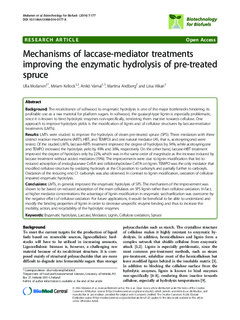| dc.description.abstract | Background: The recalcitrance of softwood to enzymatic hydrolysis is one of the major bottlenecks hindering its profitable use as a raw material for platform sugars. In softwood, the guaiacyl-type lignin is especially problematic, since it is known to bind hydrolytic enzymes non-specifically, rendering them inactive towards cellulose. One approach to improve hydrolysis yields is the modification of lignin and of cellulose structures by laccase-mediator treatments (LMTs).
Results: LMTs were studied to improve the hydrolysis of steam pre-treated spruce (SPS). Three mediators with three distinct reaction mechanisms (ABTS, HBT, and TEMPO) and one natural mediator (AS, that is, acetosyringone) were tested. Of the studied LMTs, laccase-ABTS treatment improved the degree of hydrolysis by 54%, while acetosyringone and TEMPO increased the hydrolysis yield by 49% and 36%, respectively. On the other hand, laccase-HBT treatment improved the degree of hydrolysis only by 22%, which was in the same order of magnitude as the increase induced by laccase treatment without added mediators (19%). The improvements were due to lignin modification that led to reduced adsorption of endoglucanase Cel5A and cellobiohydrolase Cel7A on lignin. TEMPO was the only mediator that modified cellulose structure by oxidizing hydroxyls at the C6 position to carbonyls and partially further to carboxyls. Oxidation of the reducing end C1 carbonyls was also observed. In contrast to lignin modification, oxidation of cellulose impaired enzymatic hydrolysis.
Conclusions: LMTs, in general, improved the enzymatic hydrolysis of SPS. The mechanism of the improvement was shown to be based on reduced adsorption of the main cellulases on SPS lignin rather than cellulose oxidation. In fact, at higher mediator concentrations the advantage of lignin modification in enzymatic saccharification was overcome by the negative effect of cellulose oxidation. For future applications, it would be beneficial to be able to understand and modify the binding properties of lignin in order to decrease unspecific enzyme binding and thus to increase the mobility, action, and recyclability of the hydrolytic enzymes. | nb_NO |

